Regular pellet stove upkeep is essential for maintaining efficiency and performance. By cleaning the burn pot, inspecting the exhaust system, and checking door gaskets, you'll guarantee peak combustion and heat output. Emptying the ash pan and cleaning air intake vents prevents blockages that can hinder airflow. Lubricating moving parts and verifying thermostat functionality keeps your stove running smoothly. Don't forget to inspect electrical components and test safety features regularly. These maintenance tasks not only improve efficiency but also extend your stove's lifespan and reduce fuel consumption. By understanding the importance of each maintenance step, you'll be well-equipped to keep your pellet stove in top condition.
Cleaning the Burn Pot
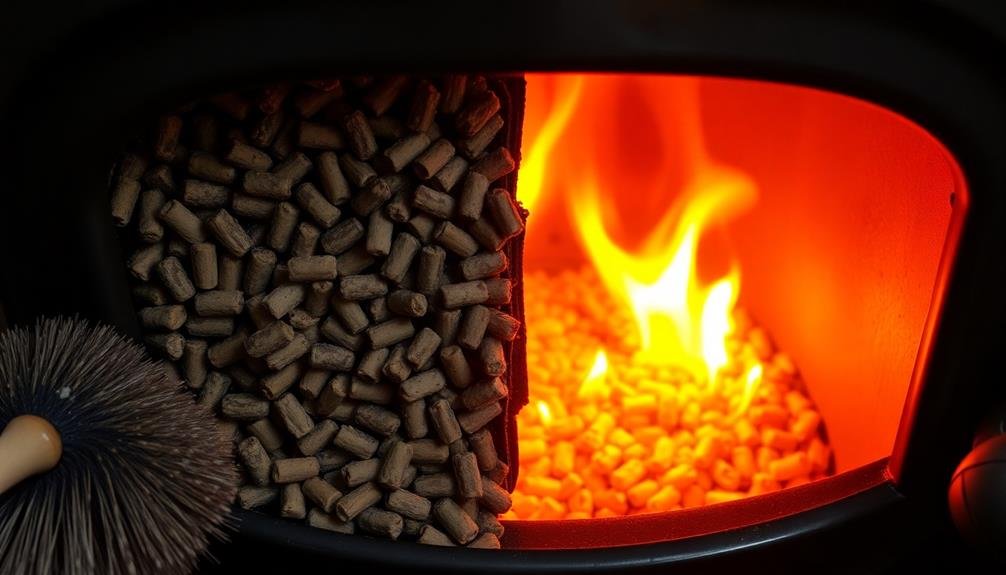
The burn pot is the heart of your pellet stove. It's where pellets are burned to create heat, making its cleanliness essential for ideal performance. You'll need to clean the burn pot regularly, typically every 1-3 days depending on usage.
To clean the burn pot, start by shutting off the stove and letting it cool completely. Once cool, remove the burn pot and empty any ash or unburned pellets into a metal container. Use a wire brush to scrub away any stubborn buildup on the pot's surfaces and air holes.
Pay special attention to these holes, as they're vital for proper air circulation.
Next, vacuum the area where the burn pot sits, removing any debris that may have fallen through. Inspect the pot for any signs of warping or damage. If you notice any issues, consider replacing the burn pot to maintain efficiency.
Before reinstalling the burn pot, check the gasket seal around its base. Replace it if it's worn or damaged to prevent air leaks.
Inspecting the Exhaust System
Regularly inspect your pellet stove's exhaust system to guarantee peak performance and safety.
Check for any blockages in the system and clean the vent pipes thoroughly to remove built-up creosote and debris.
Don't forget to examine the exterior termination, guaranteeing it's free from obstructions and in good condition.
Check for Blockages
Inspecting your pellet stove's exhaust system for blockages is crucial for safe and efficient operation. Blockages can occur due to various reasons, including ash buildup, bird nests, or debris accumulation.
To check for blockages, start by examining the exhaust vent pipe from the outside of your home. Look for any visible obstructions or signs of damage.
Next, inspect the interior components of the exhaust system. Remove the exhaust pipe from the stove and use a flashlight to look inside. You'll want to check for any buildup of creosote, ash, or other debris. If you notice any blockages, use a brush or vacuum designed for pellet stoves to clean them out thoroughly.
Don't forget to check the combustion blower as well. This component can accumulate ash and debris over time, potentially causing blockages. Remove the blower and clean it carefully, making sure all vanes are free from obstructions.
Lastly, inspect the air intake pipe for any blockages. This pipe brings in fresh air for combustion, and any obstructions can greatly impact your stove's performance. Clear any debris you find and make sure the pipe is securely connected.
Clean Vent Pipes
Keeping your pellet stove's vent pipes clean goes hand in hand with inspecting the exhaust system. These pipes are essential for expelling combustion gases and maintaining proper airflow. Over time, they can accumulate ash, creosote, and other debris, which can lead to reduced efficiency and potential safety hazards.
To clean your vent pipes, you'll need a brush specifically designed for this purpose. Start by disconnecting the pipes from the stove and taking them outside. Use the brush to scrub the interior thoroughly, paying special attention to any bends or joints where buildup tends to occur.
For hard-to-reach areas, consider using a vacuum with a narrow attachment. While cleaning, inspect the pipes for any signs of damage, such as cracks or corrosion. Replace any compromised sections immediately.
Don't forget to check the exterior vent cap as well, removing any obstructions like leaves or animal nests. After cleaning, reassemble the vent system, making sure all connections are tight and secure.
This process should be done at least once a year, or more frequently if you use your pellet stove heavily. Regular maintenance of your vent pipes will help guarantee your stove operates efficiently and safely throughout the heating season.
Inspect Exterior Termination
Safety and efficiency hinge on a properly functioning exterior termination for your pellet stove's exhaust system. Regular inspection of this component is vital to guarantee peak performance and prevent potential hazards.
Start by examining the exterior vent cap for any signs of damage, rust, or obstruction. Look for bird nests, leaves, or other debris that might block the exhaust flow.
Check that the vent cap's screen is intact and free from buildup. A clogged screen can restrict airflow, leading to poor combustion and increased creosote accumulation.
Confirm the vent pipe extends far enough from your home's exterior wall to prevent exhaust gases from re-entering through windows or other openings.
Inspect the area around the termination for any discoloration or scorching, which could indicate a leak or improper installation.
Verify that the vent pipe maintains the correct clearance from combustible materials as specified by the manufacturer.
If you notice any issues or aren't confident in your assessment, don't hesitate to call a professional. They can perform a thorough inspection and address any problems to keep your pellet stove running safely and efficiently.
Checking the Door Gasket
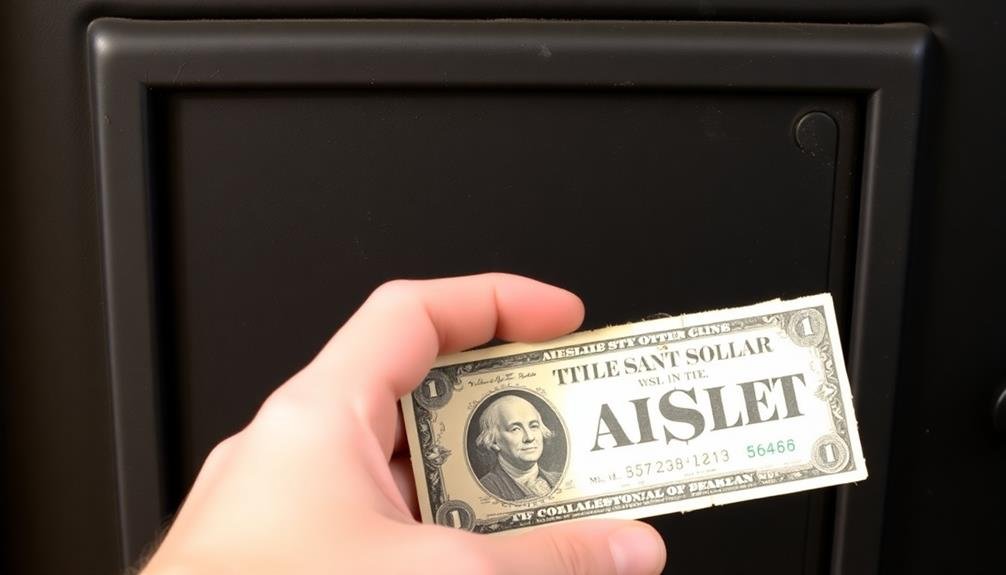
Regularly inspect your pellet stove's door gasket for signs of wear, including cracks, gaps, or flattening.
You can test the seal's integrity by closing the door on a dollar bill and trying to pull it out; if it slides out easily, your gasket needs attention.
Maintain or replace the gasket as needed to guarantee proper stove operation and efficiency.
Signs of Wear
One essential sign of wear to check on your pellet stove is the door gasket. This rubber seal guarantees that your stove maintains proper airflow and prevents smoke from escaping into your home. Over time, the gasket can become compressed, cracked, or brittle, compromising its effectiveness.
To inspect it, open the stove door and look closely at the gasket's condition. You'll want to check for:
- Visible gaps between the gasket and the door frame
- Flattened or hardened sections of the gasket material
- Frayed edges or pieces falling off
If you notice any of these issues, it's time to replace the gasket. A worn gasket can lead to decreased efficiency, higher fuel consumption, and potential safety hazards.
To test the gasket's seal, close the door on a dollar bill and try to pull it out. If it slides out easily, the gasket isn't sealing properly.
Don't ignore this vital component of your pellet stove. Regular inspection and timely replacement of the door gasket will help maintain your stove's performance, safety, and efficiency.
Testing Seal Integrity
A simple yet effective method for testing your pellet stove's door gasket integrity is the dollar bill test. Close the door on a dollar bill, then try to pull it out. If you feel resistance, the seal is likely in good condition. If the bill slips out easily, it's time to replace the gasket.
You'll want to perform this test at multiple points around the door, as wear can be uneven. Pay special attention to the corners, where gaskets often deteriorate first.
Don't forget to check the ash pan door gasket as well, if your model has one.
If you've determined that your gasket needs replacement, don't delay. A faulty seal can greatly reduce your stove's efficiency and even pose safety risks. You can usually find replacement gaskets specific to your stove model at hardware stores or through the manufacturer.
When replacing the gasket, make sure you thoroughly clean the door channel first.
Apply a thin bead of high-temperature silicone adhesive before pressing the new gasket into place. Allow it to cure fully before using your stove again.
Replacement and Maintenance
While testing your pellet stove's door gasket is vital, knowing how to replace and maintain it's equally important. A worn-out gasket can lead to heat loss and reduced efficiency, so it's essential to keep it in top condition.
When you've determined that your gasket needs replacement, follow these steps:
- Remove the old gasket carefully, making sure you don't damage the door surface.
- Clean the gasket channel thoroughly, removing any debris or adhesive residue.
- Apply a thin layer of high-temperature silicone adhesive to the channel before installing the new gasket.
You'll want to replace your door gasket every 1-2 years, depending on usage.
To maintain it between replacements, clean it gently with a soft brush and vacuum any loose debris. Avoid using harsh chemicals or abrasive materials that could damage the gasket material.
Remember to check the gasket's compression regularly by closing the door on a dollar bill. If you can easily pull the bill out, it's time for a replacement.
Emptying the Ash Pan
How often should you empty your pellet stove's ash pan? The frequency depends on your stove's usage and the quality of pellets you're burning. Generally, you'll need to empty it every few days to a week during heavy use. High-quality pellets produce less ash, allowing for longer intervals between cleanings.
You'll know it's time to empty the ash pan when it's about two-thirds full. Don't let it overflow, as this can impede airflow and reduce your stove's efficiency.
To empty the pan, verify the stove is cool and turned off. Remove the pan carefully to avoid spilling ash. Dispose of the ash in a metal container with a tight-fitting lid, as embers can remain hot for days.
While emptying the ash pan, take the opportunity to inspect it for any damage or warping. Clean the area around the pan and check for ash buildup in other parts of the stove.
Regular ash removal not only improves your stove's performance but also reduces the risk of fire hazards. Make this task a part of your routine maintenance to keep your pellet stove running smoothly and safely.
Lubricating Moving Parts
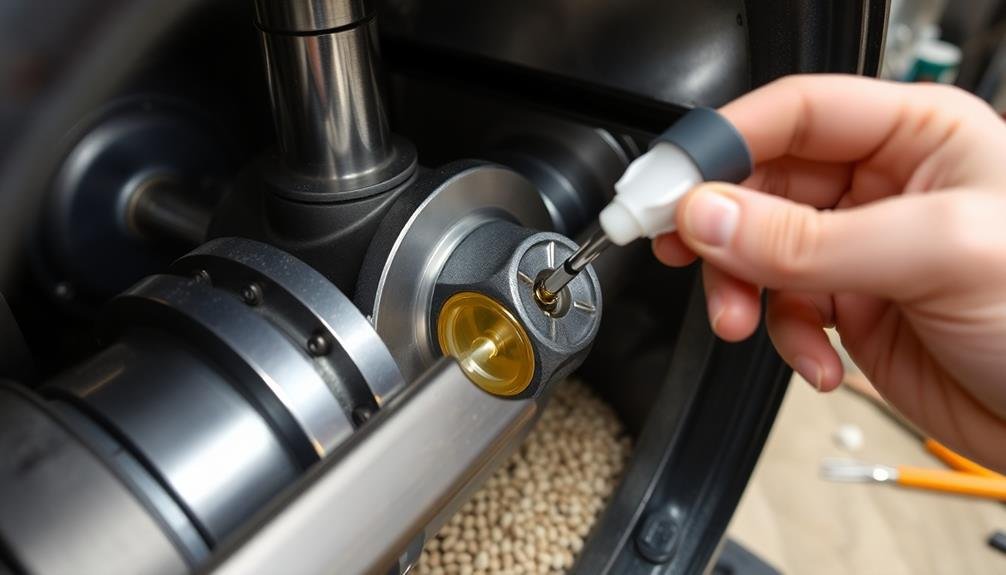
Lubricating your pellet stove's moving parts is essential for preventing unnecessary wear and tear.
You'll extend the lifespan of components like augers, fans, and motors by applying the manufacturer-recommended lubricant regularly.
This simple maintenance task guarantees smooth operation, reducing the risk of breakdowns and improving your stove's overall efficiency.
Preventing Wear and Tear
Proper lubrication is the key to extending your pellet stove's lifespan and ensuring smooth operation. By regularly lubricating moving parts, you'll prevent excessive wear and tear that can lead to costly repairs or replacements. Focus on areas like the auger, blower motors, and door hinges, applying a high-temperature lubricant as recommended by your stove's manufacturer.
To further prevent wear and tear on your pellet stove, follow these essential steps:
- Clean the burn pot daily to remove ash buildup, which can cause uneven burning and damage to internal components.
- Inspect and clean the exhaust system annually to prevent creosote accumulation and maintain proper airflow.
- Use high-quality pellets to reduce clinker formation and minimize the risk of damage to the auger and burn pot.
Don't forget to check and replace gaskets as needed to maintain an airtight seal.
Regularly inspect electrical connections and wiring for signs of wear or damage.
Smooth Operation Benefits
With regular lubrication of moving parts, you'll enjoy numerous benefits that contribute to your pellet stove's smooth operation.
By keeping components like augers, fans, and motors well-oiled, you'll reduce friction and prevent premature wear. This maintenance step not only extends the lifespan of these essential parts but also guarantees they function at peak efficiency.
You'll notice a significant reduction in noise levels when your pellet stove's moving parts are properly lubricated. The quieter operation enhances your comfort and allows for a more peaceful home environment.
Additionally, well-maintained components require less energy to operate, potentially lowering your electricity costs.
Regular lubrication also helps prevent unexpected breakdowns. When moving parts are adequately greased, they're less likely to seize up or malfunction, reducing the risk of costly repairs or replacements.
You'll also experience more consistent heat output as the stove operates smoothly without interruptions.
Cleaning the Glass Viewing Panel
The glass viewing panel on your pellet stove can quickly accumulate soot and ash, obscuring your view of the fire. Regular cleaning of this panel is crucial for both aesthetic and functional reasons. A clean glass allows you to monitor the flame quality and guarantee your stove is operating efficiently.
It also enhances the ambiance of your living space, allowing you to enjoy the warm glow of the fire.
To clean your pellet stove's glass panel effectively:
- Wait for the stove to cool completely before attempting to clean the glass.
- Use a specialized pellet stove glass cleaner or a mixture of white vinegar and water.
- Apply the cleaner with a soft cloth, avoiding abrasive materials that could scratch the glass.
Don't neglect this important maintenance task. A buildup of residue on the glass can actually affect your stove's heat output by reducing the amount of radiant heat that enters your room.
Additionally, a dirty glass panel can make it difficult to spot potential issues with your stove's burning pattern. By keeping the glass clean, you'll guarantee peak performance and enjoy a clear view of your cozy fire.
Examining the Auger System
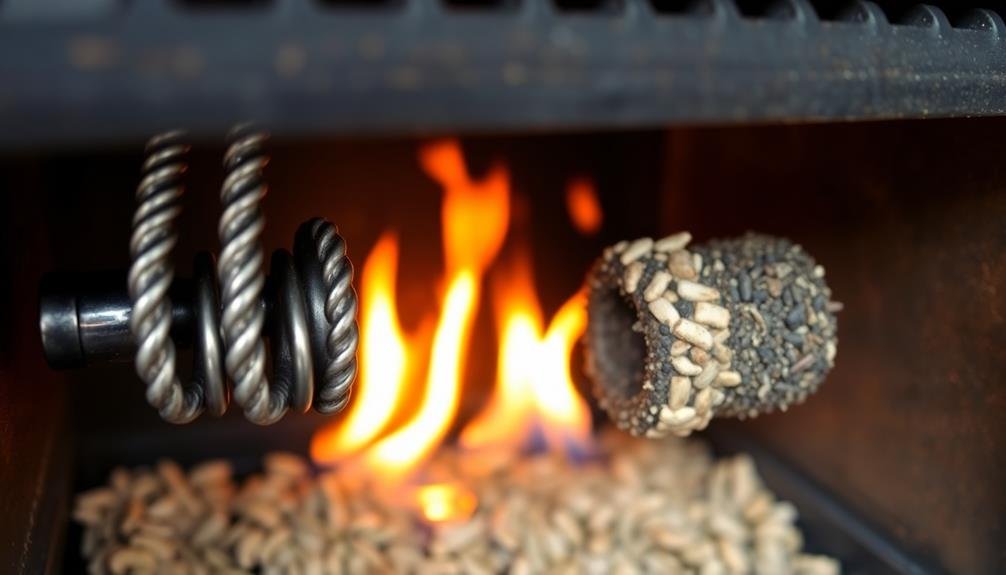
Your pellet stove's auger system plays an essential role in its operation, feeding pellets from the hopper into the burn pot at a controlled rate. Regularly examining this system guarantees your stove continues to function efficiently and safely.
Start by unplugging your stove and allowing it to cool completely. Remove the side panel to access the auger motor and mechanism. Check for any visible damage, wear, or misalignment.
Listen for unusual noises when the auger operates, which may indicate bearing issues or motor problems. Inspect the auger shaft for any bends, cracks, or excessive wear. Confirm it's properly lubricated according to the manufacturer's instructions.
Check the auger flights (the spiral blades) for damage or warping, as these can affect pellet flow. Examine the hopper for any debris or clumped pellets that might obstruct the auger's intake.
Clean out any sawdust or fines that have accumulated, as these can jam the system. If you notice any issues during your inspection, consult your owner's manual or a professional technician.
Don't attempt repairs unless you're confident in your ability to do so safely and correctly. Regular auger system examinations can prevent costly breakdowns and confirm your pellet stove operates at peak efficiency.
Verifying Thermostat Functionality
Proper thermostat functionality is essential for maintaining ideal performance of your pellet stove. A well-functioning thermostat guarantees your stove operates efficiently, providing consistent heat and conserving fuel.
To verify your thermostat's functionality, you'll need to conduct a few simple tests and observations. Start by setting your thermostat to different temperatures and monitoring how your pellet stove responds. It should cycle on and off appropriately based on the room temperature and your desired setting. If you notice any delays or inconsistencies, it's time to investigate further.
Here are three key steps to verify your thermostat's functionality:
- Check the wiring connections between the thermostat and the stove
- Clean the thermostat's internal components to remove dust and debris
- Test the thermostat with a multimeter to confirm it's sending the correct signals
If you're unsure about performing these tests yourself, don't hesitate to consult a professional.
Regular thermostat maintenance will help you avoid unexpected breakdowns and guarantee your pellet stove continues to operate efficiently throughout the heating season.
Cleaning Air Intake Vents
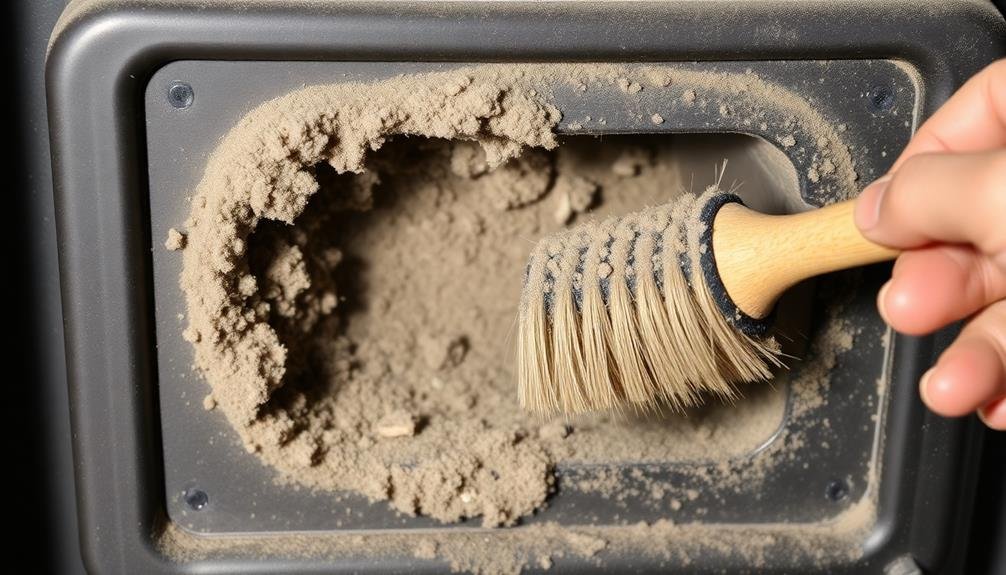
In accordance with maintaining ideal performance, cleaning air intake vents is an essential step in pellet stove maintenance. These vents supply the oxygen necessary for efficient combustion, and when they're clogged, your stove's efficiency plummets.
To clean them, first turn off and unplug your stove. Locate the air intake vents, usually found on the back or sides of the unit.
Use a soft brush or vacuum cleaner with a brush attachment to remove dust and debris from the vent openings. Be thorough but gentle to avoid damaging the vents. For stubborn buildup, you can use a damp cloth, but make sure the area is completely dry before restarting the stove.
Don't forget to check and clean the outdoor vent cap as well, as it can accumulate leaves, insects, or other outdoor debris.
Aim to clean these vents at least once a month during the heating season, or more frequently if you use your stove heavily. By keeping your air intake vents clean, you'll guarantee proper airflow, improve combustion efficiency, and reduce the risk of performance issues or safety hazards in your pellet stove.
Inspecting Electrical Components
Inspecting the electrical components of your pellet stove is essential for guaranteeing safe and efficient operation. Regular checks can prevent electrical failures, reduce fire risks, and extend your stove's lifespan.
Start by unplugging the stove and removing the access panel to expose the internal electrical parts.
Once inside, focus on these key areas:
- Wiring connections: Check for loose, frayed, or damaged wires. Tighten any loose connections and replace damaged wires immediately.
- Circuit board: Look for signs of corrosion, burn marks, or other damage. A faulty circuit board can cause erratic stove behavior or complete failure.
- Blower motors: Inspect the wiring and connections to the combustion and convection blowers. Confirm they're secure and free from debris.
Don't forget to examine the power cord for any wear or damage.
If you're uncomfortable performing these checks yourself, don't hesitate to call a professional. They can conduct a thorough inspection and address any issues they find.
Testing Safety Features
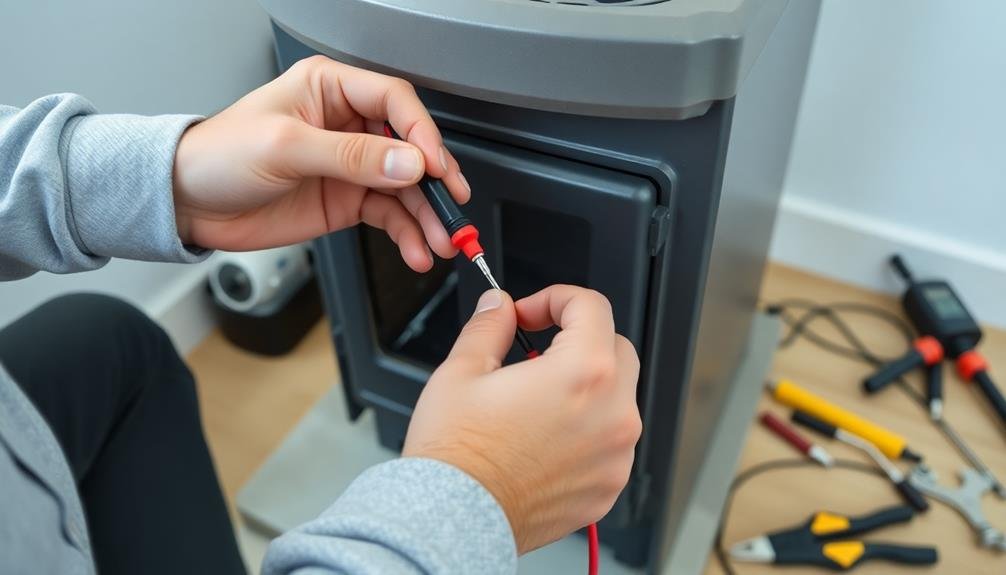
Regular testing of your pellet stove's safety features is vital for maintaining a secure heating environment.
Start by checking the pressure switch, which shuts off the auger if the exhaust system becomes blocked. Test it by temporarily blocking the exhaust pipe and confirming the stove shuts down.
Next, verify the operation of the overheat sensor, typically located near the hopper. This sensor prevents the stove from overheating by cutting power if temperatures exceed safe levels.
Don't forget to test the flame sensor, which detects the presence of fire in the burn pot. Cover it briefly to simulate flame loss and confirm the stove responds appropriately.
Check the door switch, verifying it stops pellet feed when the door is opened.
Finally, test the convection blower's thermal switch, which activates the blower when the stove reaches operating temperature.
You'll also want to inspect and test your carbon monoxide and smoke detectors, as they're important safeguards when operating any combustion appliance.
Replace batteries and update these devices as needed.
Frequently Asked Questions
How Often Should I Schedule Professional Maintenance for My Pellet Stove?
You should schedule professional maintenance for your pellet stove annually, ideally before the heating season begins. This will guarantee peak performance, safety, and efficiency. Don't skip it, as regular upkeep can prevent costly repairs and extend your stove's lifespan.
Can I Use Any Type of Pellets in My Stove?
No, you can't use just any pellets. You'll need to use pellets specifically made for your stove model. Using the wrong type can damage your stove, reduce efficiency, and void your warranty. Always check your manual for recommendations.
What's the Average Lifespan of a Well-Maintained Pellet Stove?
A well-maintained pellet stove can last 15-20 years. You'll get the most out of your stove by cleaning it regularly, replacing worn parts, and using high-quality pellets. Don't forget annual professional inspections to guarantee peak performance.
How Do I Troubleshoot Issues With Pellet Feed or Ignition?
You'll want to check for blockages in the auger and hopper. Clean out ash buildup, guarantee proper airflow, and verify the igniter's functionality. Don't forget to inspect electrical connections and confirm you're using high-quality pellets.
Are There Any Energy-Saving Tips for Operating a Pellet Stove Efficiently?
You can save energy with your pellet stove by using high-quality pellets, maintaining proper airflow, cleaning regularly, sealing your home, and using a programmable thermostat. Don't forget to adjust settings based on outside temperatures for maximum efficiency.
In Summary
You've seen how vital regular pellet stove maintenance is for efficiency and safety. By keeping up with these tasks, you'll guarantee your stove runs smoothly, uses less fuel, and lasts longer. Don't neglect these simple steps; they'll save you money and headaches in the long run. Remember, a well-maintained pellet stove isn't just more efficient—it's safer for your home. Make upkeep a priority, and you'll enjoy cozy, worry-free warmth all season long.

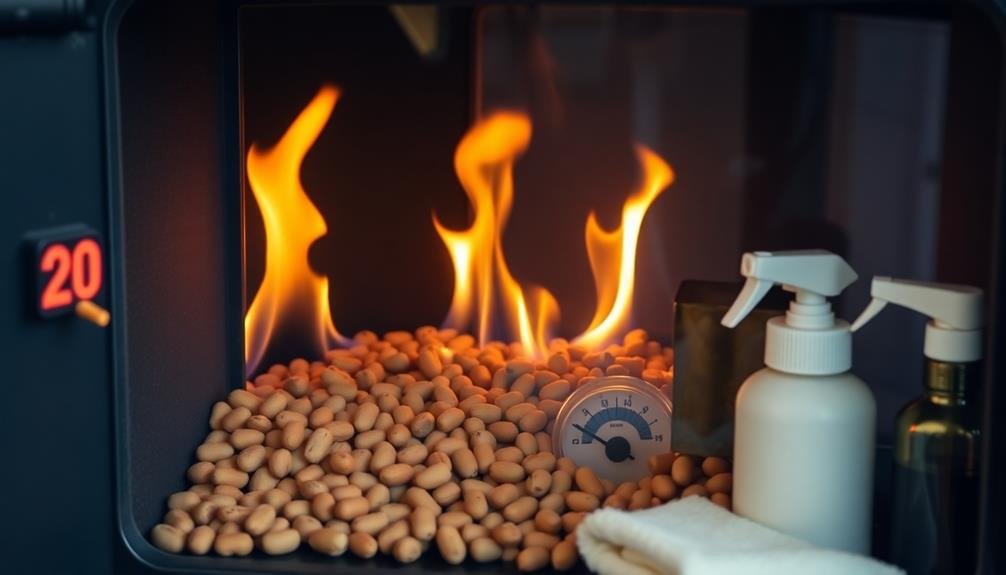



Leave a Reply